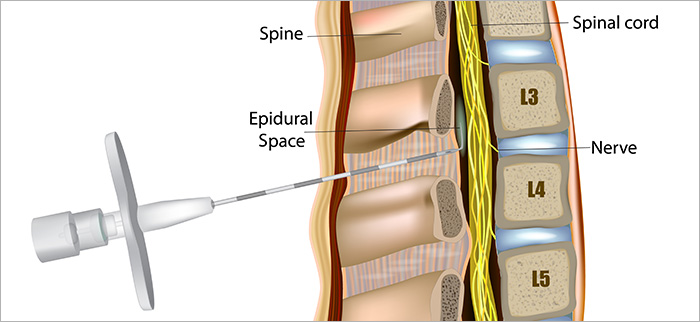Epidural Steroid Injections
The epidural space is between the dural sac (a membrane encasing the spinal cord, spinal fluid, and nerve roots) and the vertebral wall, inside the spinal canal but outside the nerve sac.
An epidural steroid injection (ESI) is an injection that delivers long-acting steroids directly into the epidural space. The steroids help to reduce pain by reducing inflammation around the nerves. Sometimes an anesthetic or saline is also used to help “flush out” inflammatory agents that may be irritating a nerve.
 Treatments
Treatments
Epidural steroid injections are typically used to treat pain radiating from the lower back into the legs or from the neck into the arms. Diagnoses most often considered for ESI include:
- Herniated Disc
- Stenosis
- Nerve Root Compression
- In some cases Spondylolisthesis
What to Expect

Once you have decided to have the injection, the following events take place:
- Do not eat or drink anything after midnight before your injection.
- You can take your regular heart and blood pressure medications on the morning of the injection with a sip of water. Check with your doctor regarding taking diabetes medications prior to the injection.
- Discontinue taking anti-inflammatories three days before the steroid injection.
- Discontinue taking aspirin products and other blood thinners seven days before the steroid injection.
- If on blood thinners, call the physician who prescribed the medication to get approval to stop taking them before the steroid injection.




- The patient lies flat on his/her abdomen on an X-ray table.
- The skin is numbed with lidocaine. The skin is numbed with lidocaine. Intravenous sedation may be requested by the patient.
- Using fluoroscopy (live X-ray) for guidance, the physician directs a needle toward the epidural space. Fluoroscopy is considered important so that the physician can more easily determine if the needle is in the right place.
- The steroid solution is injected (you may feel heaviness and/or numbness in your legs caused by the anesthetic). This generally lasts only a few hours.
An epidural steroid injection usually takes between 15 and 30 minutes.




- Following the steroid injection, the patient is usually monitored 15 to 20 minutes before being discharged to go home.
- It is important that the patient have someone drive him/her home after the steroid injection.
- Patients are usually asked to rest on the day of the injection.
- Normal activities (those that were done the week prior to the injection), including work, may typically be resumed the following day. Please note that your back may be sore for 24 to 48 hours.
- There is no definitive research to dictate how often a patient should have epidural steroid injections. In general, it is considered reasonable to perform up to three epidural steroid injections per year, but no more than four during this period. The decision to do a series of injections is usually based on the patient’s response to the first injection.
Frequently Asked Questions
ESI is performed in either a hospital or ambulatory surgery center (ASC) using x-ray guidance. After the skin is carefully cleaned and numbed with a local anesthetic (similar to what dentists use to numb the gums to fill cavities), a needle is carefully introduced into the spinal canal.
After the needle placement is confirmed with the x-ray, often confirmed by a small amount of dye, the ESI is administered.
The whole procedure only takes approximately 10-20 minutes to perform, but patients are then monitored for a short period of time before going home.
Typically ESI is not a very painful procedure. Local anesthetics are used to minimize the discomfort from the needle. Sedation can also be used to reduce pain and make the patients more comfortable during the procedure, especially if they are nervous.
ESI are performed at Texas Back Institute by fellowship-trained, board-certified spine surgeons and physical medicine and rehabilitation specialists.
The general guideline is that a person can have up to 4 epidural steroid injections per year. If a patient gets excellent results with just one or two, then additional injections may not be needed. Every patient’s response is different.
Most major medical insurance plans, including Blue Cross/Blue Shield, United Healthcare, Aetna, Cigna, and Medicare, cover ESI, but they are still subject to the same deductible and co-payments as other health care procedures.
For some patients, if a patient does not get adequate relief with a steroid injection, surgery may be an alternative.
Certainly, the decision to have surgery and the type of surgery is a very personal one made on a case-by-case basis between the surgeon and the patient.
At Texas Back Institute, we pride ourselves on delivering personalized treatment plans for each patient so that they are getting the most effective, most cost-conscious care possible.


 Treatments
Treatments